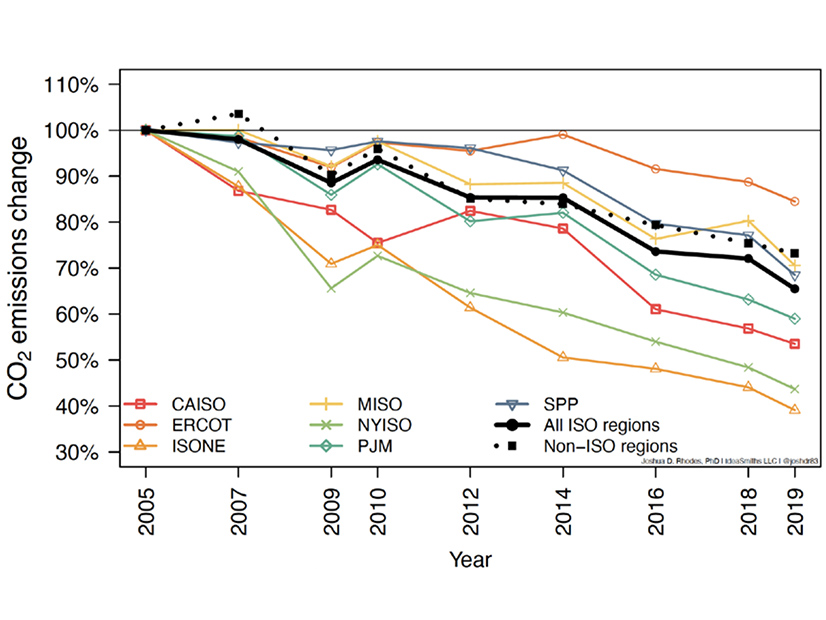
A panel of conservative electricity market experts on Tuesday argued that markets work better than public policy at encouraging and developing clean energy resources.
“Private capital is foaming at the mouth to get in these markets, and the obstacle is outmoded regulation,” Devin Hartman, director of energy and environmental policy at conservative think tank R Street Institute, said at a webinar hosted by ConservAmerica, a conservative environmental advocacy group. Formerly known as Republicans for Environmental Protection, the group argues that “the most efficient way” of developing clean energy resources “is through policies that encourage competitive markets, private investment and expanded trade.”
The private sector wants to invest in building the infrastructure needed for a clean energy future, said Hartman, former CEO of the Electricity Consumers Resource Council (ELCON). He called for re-evaluating the regulatory structure.
Hartman was joined by current ELCON CEO Travis Fisher.
“A different way to view it is the difference between a state-level mandate versus a corporate goal,” said Fisher, previously economic adviser to former FERC Commissioner Bernard McNamee. A corporate goal can be dropped if things go poorly, there are reliability issues or the cost is too high, he said.
“It doesn’t take an act of state or Congress to drop that,” Fisher said. “The more rigid and the more top-down mandated it is, that’s where you get into problems. [Policy questions] can be borne out through voluntary transactions … instead of saying, ‘We know the answer has to be X, and we have to do it by year Y.’ I don’t think that’s the correct way to go about it.”
The discussion was framed the around a new report by the Energy Choice Coalition (ECC) on the environmental benefits of competition in electricity markets, which found that RTO/ISO regions have reduced their power sector CO2 emissions by about 35% from 2005 levels, while non-RTO regions have reduced theirs by about 27%.
Furthermore, the report found that RTO regions with more competitively owned generation, such as ISO-NE, NYISO and PJM, posted even deeper reductions: 61%, 56% and 41%, respectively, said Joshua Rhodes, research associate at the University of Texas at Austin and a founding partner of energy consultancy IdeaSmiths, which conducted the study.
 Clockwise from top left: Robert Dillon, Energy Choice Coalition; Landon Stevens, Conservative Energy Network; Joshua Rhodes, University of Texas Austin; Travis Fisher, ELCON; and Devin Hartman, R Street Institute | ConservAmerica
Clockwise from top left: Robert Dillon, Energy Choice Coalition; Landon Stevens, Conservative Energy Network; Joshua Rhodes, University of Texas Austin; Travis Fisher, ELCON; and Devin Hartman, R Street Institute | ConservAmericaThe study also found that RTO/ISO regions deployed almost 80% of all utility-scale renewable generation capacity, despite accounting for 67% of all existing power plant capacity. In addition, RTO/ISO regions have seen stronger growth in distributed solar PV, increasing by about 214% versus non-ISO regions at 199%.
“You’re never going to get a pure market in this area because there are a lot of different drivers,” said Robert Dillon, executive director of the ECC and a member of the leadership team at ConservAmerica.
The environmental and regulatory aspects of the wholesale level also apply to retail, whether for the large corporations like Google and Microsoft wanting a certain supply of clean energy, or private homeowners that want to install storage or solar, Dillon said.
“Their ability to choose is a market driver; [it’s] a great principle compared to government saying, ‘You’re going to build this traditional huge coal or gas or nuclear plant on the edge of town and running wires through the city,’” Dillon said.
The discussion of the clean energy transition tends to get stuck in a dichotomy of either the Texas model on one hand or vertically integrated markets on the other, said Landon Stevens, director of policy at Conservative Energy Network (CEN), a group of state-based clean energy advocacy organizations.
“There’s actually a lot of different policy decisions that can be made along the way,” said Stevens, who described himself as a “recovering regulator.” He previously served as policy adviser to former Arizona Corporation Commissioner Andy Tobin and his successor, current Commissioner Lea Marquez Peterson.
It’s a big opportunity when about half of the country is trying to consider what the next market designs look like, he said, referring to the West.
The West is considering “an RTO model that we designed in 1995, and I would say there’s probably a lot of changes you can make to that model that would be more tailored to today’s solutions,” Stevens said. “We need to look at those really long and hard, and that’s where we have a lot of research coming down the pipe. … What does an RTO 2.0 look like, or is there a whole new model paradigm that we need to consider to incorporate some of these new technologies and leave room for that innovation?”

